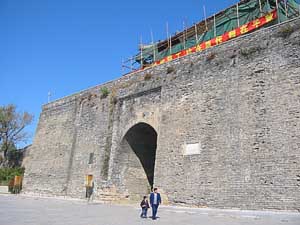Great Wall of China
The Great Wall of China (長城 in pinyin: Cháng Chéng, literal meaning: "Long City (Fortress)") is an ancient Chinese fortification, built to protect the Empire of China since the 3rd century BC against the raids of 'barbarians' from Mongolia and Manchuria. The main purpose of the Wall was not to prevent people from crossing but rather to prevent them from bringing their horses.
History
The Wall was built during the reign of The First Emperor, the main leader of the short-lived Qin dynasty. The Wall was not built out of the blue, but created by the joining of several local walls built by the Warring States. It has been renovated and extended by several later dynasties, getting most of its current shape during the Ming Dynasty. The Wall stretches over a formidable 6,400 km, from the boundary with Korea on the Yalu River (Yalu Jiang) to the Gobi desert.
There have been four major discrete constructions and renovations:
- 208 BC (the Qin Dynasty)
- 1st century BC (the Han Dynasty)
- 1138 - 1198 (the Five Dynasties and Ten Kingdoms Period)
- 1368 (the Ming Dynasty)
The Ming Dynasty Great Wall starts on the eastern end at Shanhai Pass (山海关 shan1 hai3 guan1), Qinghuangdao, in Hebei Province next to Bohai Gulf. Spanning nine provinces and 100 counties, it ends on the western end at Jiayu Pass (嘉峪关 jia1 yu4 guan1) located in northwest Gansu Province. Jiayu Pass was intended to greet travelers along the Silk Road. Even though The Great Wall ends at Jiayu Pass, there are watchtowers (烽火台 feng1 huo3 tai2) extending beyond Jiayu Pass along the Silk Road. These towers communicated by smoke to signal invasion.
The Manchus crossed the Wall by convincing a crucial general Wu Sangui to open the gates of Shahai Pass and allow the Manchus to cross. After they conquered China, the Wall was of no strategic value as the people who the Wall was intended to keep out were ruling the country.
The government ordered people to work on the wall, and workers were under constant danger of being attacked by brigades. Because many people died while building the wall, it is often called the "longest cemetery on Earth".
Structure
Significant passes (關口) include:
- Shanhai Pass (山海關)
- Juyong Pass (居庸關)
- Niangzi Pass (娘子關)
The Wall is in disrepair, serving as a playground for some villages and a source of stones to rebuild houses and roads. Sections of the Wall are also prone to graffiti. Parts have been bulldozed because the Wall is in the way of construction projects. The China Great Wall Society works to preserve the Wall. Through June 2003, the Chinese government still had no laws written to protect the Wall.
Recognition
The Wall is sometimes included in lists of the "Seven Wonders of the Modern World," but was of course not one of the classical Seven Wonders of the World recognized by the ancient Greeks.
The Wall was made a UNESCO World Heritage Site in 1987.
In 1938, Richard Halliburton's Second Book of Marvels stated that the Great Wall is the only man-made object that can be seen from the moon. This statement has persisted, assuming urban legend status and sometimes entering textbooks. If taken to mean that the Great Wall can be seen with the unaided eye from the distance of the moon, it is untrue.
However, from low earth orbit, about a thousand times nearer than the moon, it may be visible under favorable conditions. The Great Wall is only a few meters wide and is comparable to many other structures, such as highways and airport runways. Astronauts give varying reports. This variation is not surprising; amateur astronomers know that features on the moon that are dramatically visible at times can be undetectable on others, due to changes in lighting direction.
One shuttle astronaut reported that "we can see things as small as airport runways [but] the Great Wall is almost invisible from only 180 miles up." Astronaut William Pogue thought he had seen it from Skylab but discovered he was actually viewing the Grand Canal near Peking. He did succeed in spotting the Great Wall with binoculars but stated that "it wasn't visible to the unaided eye." Recently, Chinese astronaut Yang Liwei reported being unable to see it at all. An Apollo astronaut reported that no human structures at all were visible at a distance of a few thousand miles.
Veteran U.S. astronaut Gene Cernan has stated: "At Earth orbit of 160km to 320km high, the Great Wall of China is indeed visible to the naked eye."
Regardless of how visible the Great Wall is when viewed by the unaided eye from low earth orbit, the notion that the Great Wall has a unique and superlative visibility, exceeding that of other great public works, is a myth.
See also
External links
- Satellite image Great Wall of China at NASA's Earth Observatory
- Great Wall of China
- Pictures of Great Wall of China
- CBC.ca News: "Great Wall invisible from space": Chinese astronaut
- Snopes urban legend site Great Wall's lack of visibility from space
- China rewriting textbooks after astronaut fails to see Great Wall
- US astronaut: You can see the Great Wall from space

